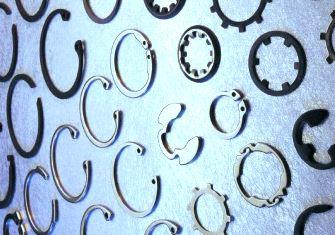Retaining rings act as a shoulder to stop the sub-component or assemblies coming off the shaft or a housing bore.
What are Retainer rings?
Retaining rings are metal fasteners that fit into a groove on a shaft or in a housing or bore to provide a shoulder that holds an assembly in place.

The purpose of a Retaining Ring is to act as a shoulder to stop the sub-component or assemblies coming off the shaft or housing bore, especially in mechanical power transmission assemblies. Various manufacturers offer various retainer rings, but all of them can be grouped under stamped and spiral wound rings. The retainer rings can also be categorized according to assembled rings. i.e., Axially or Radially.
As the name suggests, Stamped ring, sometimes called snap rings, gets the name as it’s stamped from tempered sheet metal and has a non-uniform cross-section.
Types of Retainer rings
Various designs are available from various manufacturers catering and addressing common shortfalls of the rings such as tolerance stack-up, clearance diameter, thrust load capacity, flexible and radial installation, and assembly automation.
The most common types of Retainer rings are;
- External and internal circlips
- E-clips
- Spiral Rings
- External and internal Snap Rings
You might also come across circlips with an increased abutment to increase surface area, which stops the component, and heavy-duty circlips to handle the large axial load.
Material and finish
Most commonly, the circlips are made using carbon spring steel. To cater to the highly corrosive and food industry, stainless steel versions are available from various suppliers to standard DIN 1.4122. Suppliers also have phosphor bronze and beryllium copper retainers in their stock
Advantages and Disadvantages of retaining rings
Advantages of retaining rings
- Cheaper compared to other fastening methods
- Use less raw material for a given size
- Reduce and avoid complex machinings such as threads and undercuts
- Compact design
- It can be assembly quicker
- No special training is required for assembly
- Lightweight
- Easy to install
- unlike threaded alternatives, significantly reduce the production cost
Disadvantages of retaining rings
- It can only be used once
- Special tool
- There will be a small play in the axial direction to cater for tolerance build-up.
- Less shaft/housing preparation (threading, tapping & drilling)
- Reduced weight and size of finished design